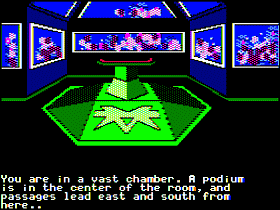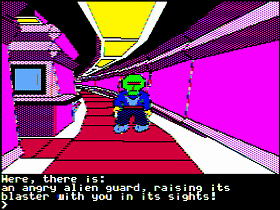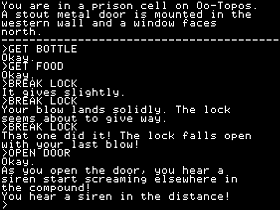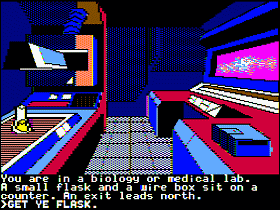 The Game: A prisoner awakens in a cell aboard an alien spaceship, parked on an unknown world. with nothing more than the meal that’s been provided and his wits, the prisoner has to escape his cell, overcome guards and automatic defense system , collect items that could help him escape his captors. The guards always seem to be just around the corner, always helpfully prepared to escort you back to your cell to start again… after a little bit of needless brutality, of course. (Polarware, 1987)
The Game: A prisoner awakens in a cell aboard an alien spaceship, parked on an unknown world. with nothing more than the meal that’s been provided and his wits, the prisoner has to escape his cell, overcome guards and automatic defense system , collect items that could help him escape his captors. The guards always seem to be just around the corner, always helpfully prepared to escort you back to your cell to start again… after a little bit of needless brutality, of course. (Polarware, 1987)
Memories: A former Infocom designer and programmer (Infidel, Suspended) who stuck around just long enough after Infocom’s acquisition by Activision to design Tass Times In Tonetown, Michael Berlyn became a freelancer after the slow-motion debacle that was the Activision/Infocom merger. One of his final Apple II games took him to Polarware (which had started out the 1980s as Penguin Software, makers of a nearly-ubiquitous Apple graphics toolkit called Graphics Magician), where he proceeded to remake one of his earliest pre-Infocom games.
 Oo-Topos had originally been released in all-text form by Sentient Software in 1981, but with Graphics Magician’s handy draw-and-fill routines, this version of Oo-Topos had graphics available to it, with players deciding early on if they wanted graphics rendered in the standard, color-poor Apple II hi-res graphics mode, or the “enhanced” hi-res mode available on late-model Apple IIe systems, the Apple IIc, and a few clone machines such as the Franklin ACE 2000 series. Text-wise, it was essentially the same game.
Oo-Topos had originally been released in all-text form by Sentient Software in 1981, but with Graphics Magician’s handy draw-and-fill routines, this version of Oo-Topos had graphics available to it, with players deciding early on if they wanted graphics rendered in the standard, color-poor Apple II hi-res graphics mode, or the “enhanced” hi-res mode available on late-model Apple IIe systems, the Apple IIc, and a few clone machines such as the Franklin ACE 2000 series. Text-wise, it was essentially the same game.
The remake of Oo-Topos was hardly the first to use draw-and-fill graphics routines; Apple II text adventure games had been trying to add graphics to their text with similar routines since Sierra‘s  Hi-Res Adventures. But they were still terribly slow, and even so much as picking up the food in the prison cell would trigger a redraw of the scene, this time without the food. One of the best features of this version of Oo-Topos was the ability to hit return without an in-game command and switch to an all-text mode; doing the same in text mode would turn the graphics back on. It was an incredibly handy option to circumvent the time-consuming graphical draw routines. (That being said, despite the limited resolution, the graphics of the various locales displayed an interesting design sense. It’s worth playing through with the pictures on.)
Hi-Res Adventures. But they were still terribly slow, and even so much as picking up the food in the prison cell would trigger a redraw of the scene, this time without the food. One of the best features of this version of Oo-Topos was the ability to hit return without an in-game command and switch to an all-text mode; doing the same in text mode would turn the graphics back on. It was an incredibly handy option to circumvent the time-consuming graphical draw routines. (That being said, despite the limited resolution, the graphics of the various locales displayed an interesting design sense. It’s worth playing through with the pictures on.)
 The story itself isn’t terribly engrossing; Oo-Topos is a scavenger hunt where you’re confined to acquiring the right items and doing the right things with them in the right order. It wasn’t much of a challenger to the more interesting prose of the average Infocom game; even though the mechanics are similar to Infocom’s interactive fiction, Infocom’s prose was usually better-written (as Berlyn’s
The story itself isn’t terribly engrossing; Oo-Topos is a scavenger hunt where you’re confined to acquiring the right items and doing the right things with them in the right order. It wasn’t much of a challenger to the more interesting prose of the average Infocom game; even though the mechanics are similar to Infocom’s interactive fiction, Infocom’s prose was usually better-written (as Berlyn’s  would be by the time he joined the elite ranks of that company’s game writers).
would be by the time he joined the elite ranks of that company’s game writers).
The 1987 edition of Oo-Topos was an interesting throwback with a new twist, but that new twist – tacking graphics onto text adventures – had already been tried elsewhere, and wasn’t much of an enhancement here.